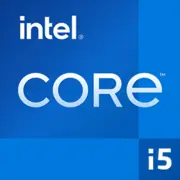Intel Core i5-11400F

Intel Core i5-11400F: Review and Relevance in 2025
April 2025
Despite the release of new generations of processors, the Intel Core i5-11400F remains a popular choice for budget builds and upgrading older systems. Let’s explore why this chip is still relevant and who it is suitable for.
1. Key Specifications: Rocket Lake in Detail
Architecture and Process Technology
The Core i5-11400F is based on the Rocket Lake architecture (2021) and is manufactured using a 14nm process. This is the last generation of Intel before the switch to 10nm (in Alder Lake). Despite its "age," the chip shows commendable performance due to its optimizations:
- 6 cores / 12 threads;
- Base clock speed of 2.6 GHz, turbo mode up to 4.4 GHz;
- 12 MB L3 cache;
- Support for PCIe 4.0 (up to 20 lanes).
Performance
According to Geekbench 6 tests (2025):
- Single-Core: 1995 — sufficient for modern games and applications;
- Multi-Core: 8199 — suitable for rendering and multitasking.
Key Features
- Intel UHD Graphics is absent (the "F" index indicates no integrated graphics);
- Support for AVX-512 for specialized tasks;
- Energy efficiency (TDP 65W).
2. Compatible Motherboards
Socket and Chipsets
The processor requires motherboards with LGA 1200. Suitable chipsets include:
- H510 — a basic option for office PCs;
- B560 — an optimal choice (unlocked RAM frequency, PCIe 4.0);
- Z590 — maximum capabilities (overclocking RAM, more ports).
Selection Features
- For PCIe 4.0, chipsets B560/Z590 are required;
- Z590 boards may be excessive — i5-11400F does not support overclocking (multiplier is locked).
Examples of 2025 Motherboards
- ASRock B560M-HDV ($75–$90) — a compact option for a budget build;
- MSI MAG B560 Tomahawk ($120–$140) — improved VRM cooling.
3. Supported Memory
Types and Frequencies
- DDR4-3200 (officially), but on B560/Z590 can be overclocked to DDR4-4000+;
- DDR5 is not supported — a key drawback for builds in 2025.
Recommendations
- Use dual-channel kits (2×8 GB or 2×16 GB);
- Optimal frequency — 3200–3600 MHz (e.g., Kingston Fury Beast DDR4-3200, $55 for 16 GB).
4. Power Supplies: Power Calculation
Power Consumption
- TDP 65W, but under load consumes up to 120–130W;
- Considering a GPU (e.g., RTX 3060), the total system power would be around ~300–350W.
Recommendations
- Minimum — 450W (for systems without a powerful GPU);
- Optimal — 550–650W (with headroom for upgrades).
Examples of Power Supplies
- Corsair CV550 ($65) — a reliable budget option;
- Seasonic Focus GX-650 ($110) — modular design, 10 years warranty.
5. Pros and Cons
Strengths
- Price ($150–$170 in 2025) — cheaper than the Ryzen 5 5600X ($180–$200);
- Good gaming performance (on par with RTX 3060 / RX 6600 XT);
- Low heat dissipation — suitable for compact cases.
Weaknesses
- Outdated 14nm process technology;
- No support for DDR5 and PCIe 5.0;
- Cannot be overclocked (unlike Ryzen with the "X" index).
6. Usage Scenarios
Gaming
- 1080p / 60+ FPS in AAA titles (Cyberpunk 2077, Elden Ring) with a GPU like the RTX 3060;
- Esports titles (CS2, Valorant) — 200+ FPS.
Work Tasks
- Video editing in Premiere Pro / DaVinci Resolve (1080p / 4K videos with proxy);
- 3D rendering in Blender (but slower than Ryzen 7 5700X).
Multimedia
- Streaming (OBS + NVENC);
- Photo editing in Lightroom.
7. Comparison with Competitors
AMD Ryzen 5 5600X
- Pros: 7nm process, overclocking, better for multi-threaded tasks;
- Cons: more expensive, requires DDR4-3600 for optimal performance.
Intel Core i5-12400F
- Pros: Alder Lake architecture (10nm), higher IPC, DDR5 support;
- Cons: price ($180), new LGA 1700 boards are more expensive.
Conclusion: The i5-11400F is a winner only in the budget segment.
8. Assembly Tips
- Cooling: even the stock cooler will suffice, but for quieter operation, choose a tower cooler like the Cooler Master Hyper 212 ($35);
- Case: with good ventilation (e.g., NZXT H510 Flow);
- Storage: An NVMe SSD is essential (Samsung 980 500 GB, $50);
- GPU: Avoid pairing with top-tier cards (an RTX 4080 will create a “bottleneck”).
9. Final Conclusion: Who is the i5-11400F Suitable For?
This processor is worth choosing if:
- Your budget is limited, and new technologies (DDR5, PCIe 5.0) are not required;
- You're upgrading an old PC on LGA 1200;
- Your main goal is gaming in Full HD or working with office applications.
In 2025, the i5-11400F is a decent compromise between price and performance, but for future upgrades, it is better to consider the LGA 1700 or AM5 platform.
Basic
CPU Specifications
Memory Specifications
GPU Specifications
Miscellaneous
Benchmarks
Compared to Other CPU
Share in social media
Or Link To Us
<a href="https://cputronic.com/en/cpu/intel-core-i5-11400f" target="_blank">Intel Core i5-11400F</a>